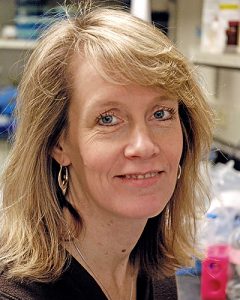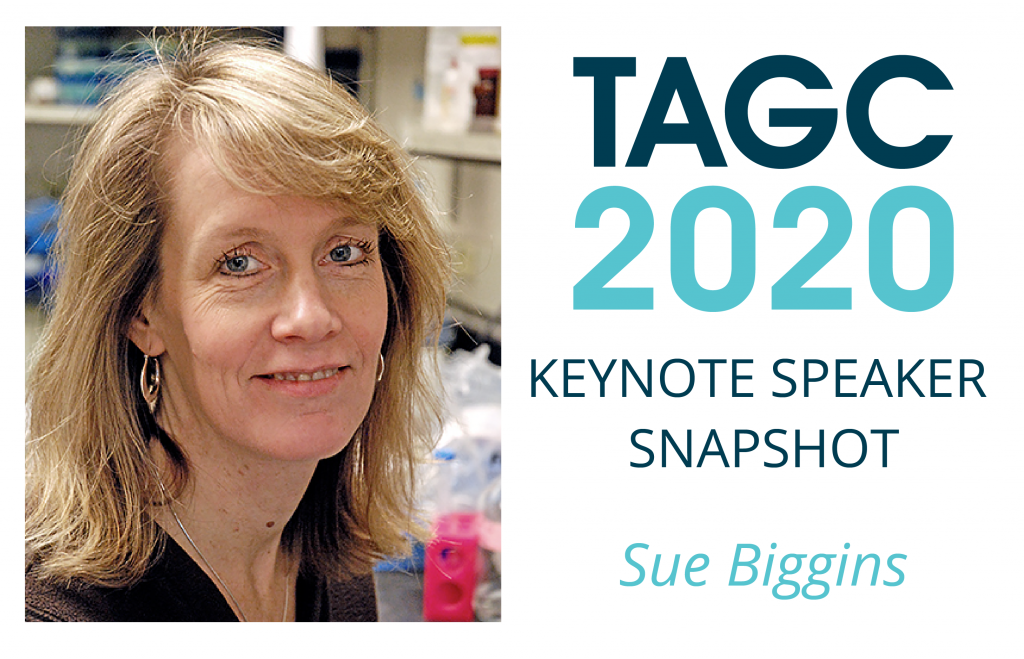Get to know the TAGC 2020 Keynote Speakers through our interview series.

Sue Biggins
Sue Biggins studies the mechanisms that ensure accurate chromosome segregation and regulation of the cell cycle. Her lab achieved the first isolation of kinetochores and has been applying structural, biophysical and biochemical techniques to elucidate the mechanisms of kinetochore-microtubule interactions and spindle checkpoint regulation. Her lab also works on the mechanisms that ensure chromatin composition and centromere identity. Biggins is currently a Senior Vice President and the Director of Basic Sciences at the Fred Hutchinson Cancer Research Center and an Investigator of the Howard Hughes Medical Institute.
What research are you most excited about right now, and why?
In terms of the chromosome segregation field and work on the kinetochore, we’ve now identified most of the parts of the machine. That was 20 years’ worth of work, identifying components and figuring out who interacts with whom. We’re at the exciting moment now of figuring out how the machine works. The kinetochore itself has many dynamic and diverse functions, and now we can ask which proteins do what functions. The field is at a great moment now, starting from a better understanding of the structure to get at the dynamics of the complex.
Everything gets stuck until there’s a new technological advance. In my field, it’s been the integration of everything: cryo-EM, biophysics, advanced cell biology, light microscopy, CRISPR-driven genetic screens. It’s an exciting time.
What do you like about working with yeast?
Funnily, we started working on human cells recently. But yeast has been the foundation of my career because of its simplicity and all of the things you hear about it as a genetic organism. I was really trained as a geneticist, and yeast has the simplest version of the process I study; there are some unique features that make it much more tractable. In yeast, there is a single microtubule that binds the kinetochore, whereas other organisms have many microtubules, so that simplifies things. Yeast have a very unusual centromere, which is sequence defined; most organisms have an epigenetically-based centromere. Some might argue that these are specialties that make yeast not relevant, but that hasn’t been true. We’ve identified a number of paradigms in yeast that have been conserved, despite these differences. And the simplicity of the system was a huge advantage. We knew the parts in yeast much earlier than in other organisms, and yeast has fewer components. The bulk of the proteins are conserved, and so are the functions.
Is there anything about yourself or the field that made you feel like you didn’t belong in science? What would you say to early career scientists struggling with the same feeling?
Like all women, I’ve faced some challenges. I was a bit naive when I came in; I thought it was something science had overcome. When I started in science and got a job, I felt like, “If they’re hiring me, they don’t have problems with women.” But as I moved on in my career, I could see the larger picture.
The needle on promoting women and underrepresented minorities in science did not move how I thought it would over the last 20 years. Looking back at it and recognizing that I made it through somehow definitely puts me on the lookout to try to help junior people so that they don’t face similar barriers.
If there are times when you feel you don’t belong or can’t do the work, remember that a lot of people go through that. It’s hard not to question yourself. I think the best thing you can do is to find a mentor and advocate—it doesn’t have to be someone in your field—who has gone through similar things to what you’re going through and find out how they got through it. That’s how I got through things.
My other key piece of advice is: don’t think that there is just one mentor. Mentoring is a spectrum, and every issue you face might require a different mentor. You might think “If I can just find my mentor, they’ll shepherd me through everything,” but it doesn’t work that way. I strongly suggest identifying the issue you’re facing and finding a mentor for that issue. Don’t assume that there’s one person who can answer everything.
TAGC aims to foster collaboration between communities and disciplines. Can you give an example of a collaboration that really helped your work?
Everything I do is completely made possible by collaboration. Chip Asbury has been my collaborator for over a decade, and our collaboration has allowed me to do things I couldn’t have imagined doing otherwise. We were able to do some biochemistry that moved the field forward, but the key thing has been combining it with biophysics. A lot of what we do is possible through collaboration with biophysicists.
There are so many advances in technology making things happen, but it’s very difficult to be an expert in all of them. The best way to be successful is to team up with the right people who know how to do what you don’t.
Select Publications from the Biggins Lab
Kinetochore-associated Stu2 promotes chromosome biorientation in vivo
Miller MP, Evans RK, Zelter A, Geyer EA, MacCoss MJ, Rice LM, Davis TN, Asbury CL, Biggins S
PLoS Genet. 2019 Oct 4;15(10):e1008423. doi: 10.1371/journal.pgen.1008423
An assay for de novo kinetochore assembly reveals a key role for the CENP-T pathway in budding yeast
Lang J, Barber A, Biggins S
Elife. 2018 Aug 17;7. pii: e37819. doi: 10.7554/eLife.37819
A TOG Protein Confers Tension Sensitivity to Kinetochore-Microtubule Attachments
Miller MP, Asbury CL, Biggins S
Cell. 2016 Jun 2;165(6):1428-1439. doi: 10.1016/j.cell.2016.04.030
The structure of purified kinetochores reveals multiple microtubule-attachment sites
Gonen S, Akiyoshi B, Iadanza MG, Shi D, Duggan N, Biggins S, Gonen T
Nat Struct Mol Biol. 2012 Sep;19(9):925-9. doi: 10.1038/nsmb.2358
Tension directly stabilizes reconstituted kinetochore-microtubule attachments
Akiyoshi B, Sarangapani KK, Powers AF, Nelson CR, Reichow SL, Arellano-Santoyo H, Gonen T, Ranish JA, Asbury CL, Biggins S
Nature. 2010 Nov 25;468(7323):576-9. doi: 10.1038/nature09594













